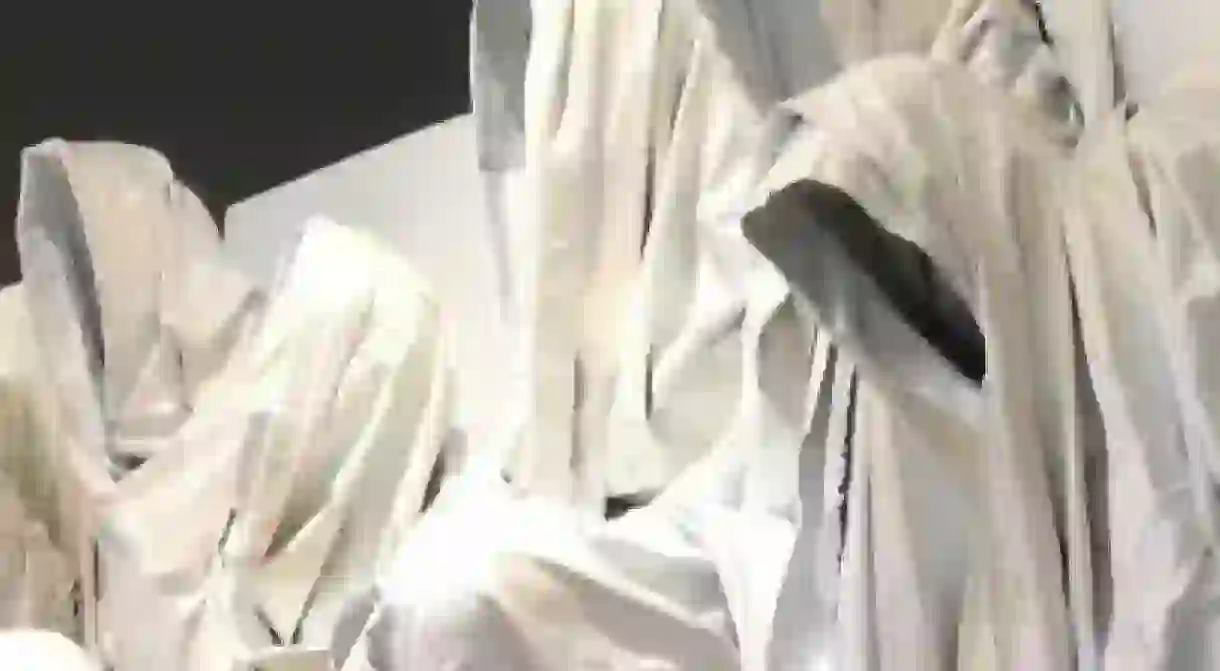Peju Alatise’s "Wrapture," Cloth, & The Human Condition

Lengths and knots of fabric stand sit, crouch, kneel, walk through doors or hang from walls: it is the sight of Peju Alatise telling the story of cloth and man. The Nigerian artist’s 2013 exhibition, Wrapture: The Story of Cloth, illustrated a fantastic realm where humans can step away from themselves and examine what they leave behind.

Peju Alatise, born in 1975, is a mixed-medium artist who resides in her homeland Nigeria. With a strong focus on the significance and power of womanhood, Peju uses clothing in her art as a literal and metaphorical representation of humans. She hopes that the resulting sense of emptiness gives the audience a moment of inflection, and an incentive to question prefabricated beliefs.
Inspired by artists such as David Dale, Bruce Onabrakpeya, Susanna Wenger, Ai Wei Wei, Louise Bourgeois and Do Ho Suh, Peju has prepared this new body of work to look past the cultural and ethnic identity of fabric and clothes. In doing so, she investigates the narratives of the individual female who wears the fabric: narratives that include intimacy, privacy, spirituality, power, beauty, death, violation and folklore. The cloth itself is presented as regular clothing items: shirts, skirts, dresses, scarves. The twist is, these items are also presented in an ‘un-sewn’ state. A contributing factor for this is the representation of cloth in western Nigeria. There, cloth is called a ‘wrapper’, thus becoming a symbol for covering all human secrets and shame. In pre-colonial Nigeria, certain wrappers were worn for specific ceremonies and certain colors worn on certain days. Intricate motifs and symbols were drawn and printed on clothing in a language specific to the ethnic group.

Wrapture, held at the Eko Hotel & Suites, was subdivided into three parts: “Resurrection,” “Earth Stories,” and “Folklore.” As Peju herself attests, “the entire show is a dramatization of fantasy, beliefs and fables. An extremely important aspect of Wrapture is Folklore. Olurombi is a Yoruba folklore story that has stopped being told and has been replaced by stories of Cinderella or dwarves. My presentation of The Rapture of Olurombi’s Daughter is a response to the hypocritical assumptions of what stories the African child should learn with. We as a people have denied ourselves and the world the benefit of our own stories. This self-denial is taught at the earliest state of intellectual maturity to ensure there is an elimination of self-worth. The Rapture of Olurombi’s Daughter is a piece which captures the exact moment when she is raptured and all that remains of her is her essence.”
Indeed, in Wrapture the woman asserts and exhibits her power through her physical absence, through her essence and even through those non-corporeal gestures, made visible in visual representation and parables. As the visitors stroll around Peju’s cloth-based constructions, they notice the fullness of their forms, and the simultaneous lack of body – lack of actual human figure. The richly-colored cloth assumes the woman’s virtual air and figures as a reminder of essence, purity, and form – or formlessness. Female forms sprouting leaves (like the Caretakers) symbolize the woman’s generative power, the woman as a life giver and vessel, as a nurturer and guardian. The sculpted projection of a winged woman who is not actually there stands proudly in Resurrection as mythical archetype of the woman who, in her strength, faces no limitation.














